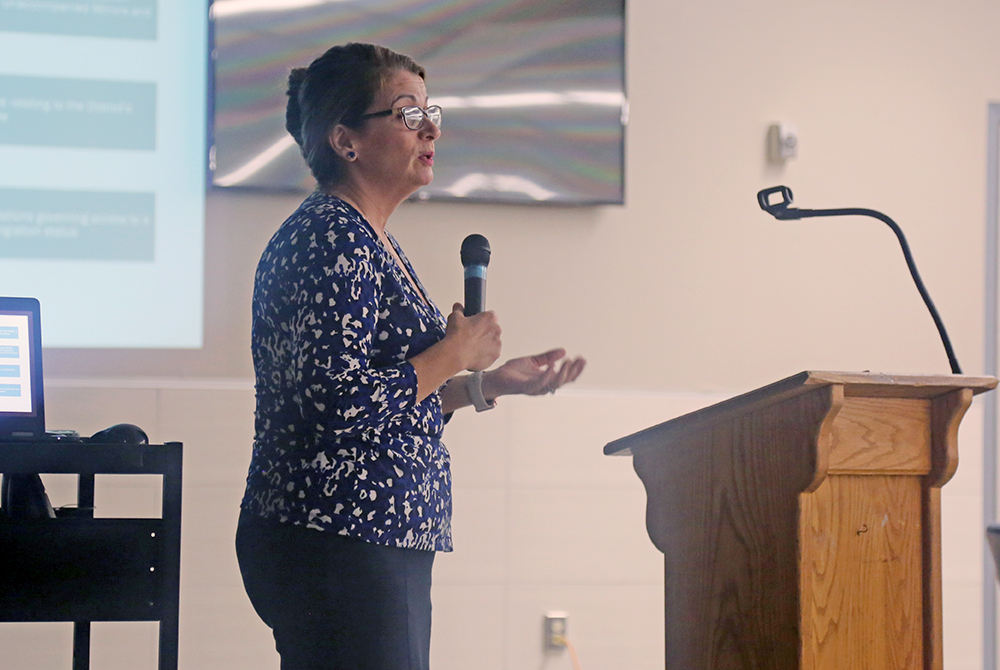Riverhead officials outline district’s registration, enrollment process

Riverhead School District officials outlined the district’s registration and enrollment process in a presentation Tuesday in response to persistent questions and criticism regarding its residency policy.
Officials noted in 2014 the district amended student registration requirements to comply with state standards after the state attorney general and Department of Education expressed concern with district policies.
Superintendent Aurelia Henriquez said the district was audited by the Department of Education in relation to its registration policy and practices based on “concern that the policies that were in place in the Riverhead School District were discriminatory” and did not comply with regulations.
In October 2014, the Department of Education issued a letter to all school districts in response to reports of districts excluding unaccompanied youth and immigrant children from enrollment, Lori Koerner, the executive director of curriculum, said.
That same month, the state agencies audited all school districts in the state, including Riverhead, to look at enrollment procedures, policies and forms to ensure they were in line with state law, according to Eileen Manitta, the pupil personnel services director.
The “compliance review” that was brought before Riverhead was intended to “ensure that districts are following the law,” Ms. Koerner said.
As a result, the district posted all enrollment materials online in January 2015, Ms. Manitta said. The district made the following changes: expedited enrollment by allowing students to enroll on the next school day while residency is being verified; could no longer deny attendance until all residency paperwork was in; determined residency within three business days of receiving that paperwork; accepted new documentation to establish physical presence within the district, including certification of age; and no longer required a social security card or any proof of immigration status to enroll.
Assistant superintendent for curriculum and instruction Christine Tona said the district determines residency based on Section 3202 of state education law.
The law states that a student’s legal residence is presumed to be the district in which the student’s parents or legal guardian reside, Ms. Tona said. However, presence alone in the district does not confer residence status.
Two factors are considered when determining residency: physical presence as an inhabitant within the district and intent to reside in the district, Ms. Tona said.
For students who do not reside with their parents or guardians, the district must determine the student’s legal residence. There must be evidence that is a child’s permanent residence.
Ms. Manitta said the Pupil Personnel Service office is responsible for verifying residency if the district has appropriate reason to suspect invalid residency. The district gets roughly one or two requests to verify residency a month, adding up to “about 20 per year.”
Dan Pace, a founding member of a new group called Riverhead Town Association of Concerned Citizens, said he found a discrepancy in the presentation, citing that “a statement by a third-party establishing a parent or persons” was not included in forms of acceptable proofs of residency. He then said the district was “misleading the public” by disseminating incorrect information.
In response, Ms. Manitta said a mandated registration guide is available on the state website, which outlines requirements. She said she would double-check the information that is visible online.
After he questioned the timeline of the policy changes, Mr. Pace said he reviewed the attorney general’s letter to the district. He said the district is permitted to review rental affidavits or rental permits since there is no mention of that in the attorney general’s letter.
“Wouldn’t that benefit the children of this district? Shouldn’t the safety of our children be the district’s No. 1 priority?” he asked.
BOND UPDATE
Former school board member Amelia Lantz said she feels that school “mis-prioritizes” sports over education in the district’s multi-million dollar bond proposal.
“In this district, education should not be an extracurricular activity, as it seems to be treated,” she said.
She added that at a prior board meeting, she said board president Greg Meyer had created the current bond project in 2015. She claimed he crafted a “mirror image” of the current bond plan with help from BBS Architects. She said it’s unfair for him to draw up the plan without the facilities committee formed.
“You had no right to predict what the community wanted solely on your own,” she said.
Mr. Meyer admitted he created a “master campus plan,” part of the former board’s goals and policies to ensure the facilities meet the needs of each student.
Board member Susan Koukounas, who was not present at the previous meeting, reminded the audience that no bond has yet been approved.
Top photo caption: Eileen Manitta, the pupil personnel services director, speaks at Tuesday’s board meeting. (Credit: Kate Nalepinski)









